 |
Glossary |
| |
 |
Fish Processing Techniques |
|
Cannery
The first cannery in BC was built in 1870 in Annieville. Soon, many canneries were being
built up and down the coast. With the opening of canneries came the expansion and growth of the
commercial fishing industry. Many different fishing methods were used to catch salmon for the
canneries. Seine boats, trollers, handliners, and gillnetters all provided
the canneries with various species of salmon to process. Most canneries had their own fishing
fleets catching fish for them but they also bought fish from independent fishermen.
Cannery in Alert Bay
© RBCM Image #pn11638
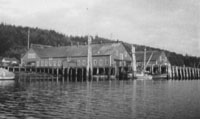
|
Until 1911 sockeye was the only species taken for canning purposes, due to the lack of a
market for other species. Later, almost every species of salmon was accepted by canneries at one
time or another, even dogfish. The species of salmon that a cannery would favour depended on
the cannery's location and the demands of the market. During WWII, dogfish - especially its
oil which was extracted from the liver of the fish - became an important commodity for canneries.
The location and quantity of canneries changed over the years as refrigeration and
automation allowed canneries to become larger and more centralized. In the beginning, canneries
were most often located near prosperous fishing grounds and First Nations villages. This was due
to the lack of refrigeration and the need for skilled labor. The women who worked on cannery
assembly lines were mostly First Nations women. These women were very skilled at their job.
Often, canneries would hire First Nations men to work in the fishing fleets in order to attract their
wives to work for the cannery. Throughout history women have typically been the dominant ones
involved in the processing and preparation of fish. For the canneries, women were cheap labor
whose small hands made them perfect for deboning and processing the fish.
Chinese men were also highly sought by the canneries as labour. Chinese workers had their
own bunkhouses at the cannery and would live on site for the canning season. When the season
was over most of them would go to Vancouver to find work. Because cannery work usually only
took place from June to September most cannery workers worked on a piecework basis.
CeePeeCee Cannery Workers
© RBCM Image #18270
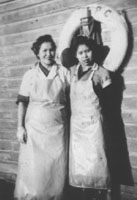 |
In the beginning, almost all the work in the canneries, from the making of packing cans to
the processing of the fish, was done by hand. This required a large labour force; as a result,
Chinese men were often hired to work in the canneries because of their skill with a fishing knife
and their cheap rates. Before automation, these men were responsible for cleaning, gutting, and
cutting off the heads, tails, and fins of the fish. They would then cut them into can sized pieces.
However, after 1906, the Smith Butchering Machine or "Iron
Chink", which cut the fish into can sized pieces, was introduced. The name "Iron Chink,"
given to this type of machine, reflected the racist feelings of the time as the machine replaced the
jobs of the Chinese men at the cannery. More advanced "Iron Chinks" would also clean and gut
the fish.
Other innovations in the industry also occurred. For instance, natural fibre nets were replaced
by new lightweight nylon nets that were more durable and easier to handle. These nets, as with
the older style ones, were dyed different colours depending on the conditions they were used in.
For example, since gillnetters often worked at night, their nets were dyed a dark colour to make
them invisible to salmon which would then swim into the nets and get their gills caught.
L to R: Ally brand canned salmon
label, and Diamond brand canned salmon label.
© Campbell River Museum
Archives
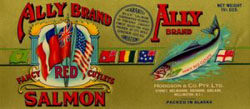 |
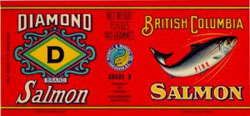 |
After the fish had been cut up, the pieces were washed again and sent down the assembly line
to the women. From there the women would put the fish in cans and send them down the line to
be salted. The cans were then weighed and checked to make sure they were not over or under
weight. When they were just right the lids were then put on the cans, they were steam-sealed, and
then cooked. Once the cans of fish had cooled they would be labeled and put in packing cases to
be shipped off to the consumers. Not all parts of the salmon were used - only the meaty part was
kept while the head, fins, tail and guts of the fish were thrown off the wharf to be eaten by
waiting dogfish.
Quathiaski Cove and Cannery,
1914. The cannery was operated by W.E. Anderson.
© Campbell River
Museum Archives Image #6715

|
The Quathiaski Cove Cannery is an example of the evolution of the cannery industry. It was
a small operation built on Quadra Island in 1904 by the Pidcock brothers. It supplied jobs to the
neighbouring First Nations peoples as well as to early European settlers coming to the area. The
cannery led to the expansion of the commercial fishing industry in the Quadra Island/Campbell
River area. However, it did not become a large enterprise until it came under the ownership of
W.E. Anderson in 1910.
The history of the Quathiaski Cannery illustrates the shift in the canning industry from the
existence of many small individually-owned operations, to the formation of a few giant
companies composed of numerous small canneries. The Quathiaski cannery was started in 1904
as a small business and was then sold in 1906 and again in 1909 to Atkins and the Quathiaski
Packing Company. After it burnt down and was rebuilt in 1910, it was transferred to the
Quathiaski Canning Company Ltd. and run by W.E. Anderson until 1938. Anderson also ran the
Blind Channel Cannery and owned a commercial fishing trap at Plumper Bay. Under Anderson's
management, the Quathiaski Cannery grew and prospered. It also provided a strong local
industry that led to the development and growth of the town of Campbell River.
Canned salmon label.
© Campbell River Museum Archives
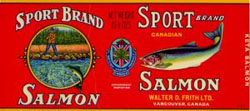
|
In 1938, the cannery, like so many others of its kind, was sold to a large corporation. The BC
Packers owned and operated several canneries along the BC coast - the Quathiaski Cove Cannery
was just one of many. In 1941, the cannery accidentally burnt down once again, while workers
stood and watched their livelihood disappear in a cloud of smoke. This time, the cannery was not
rebuilt. It was not profitable for the BC Packers to reconstruct the cannery, especially as they still
had other profitable canneries elsewhere. Unfortunately, this meant the loss of a source of
income for many seasonal workers in the Campbell River area. Moreover, the commercial
fishermen in the area had to take their fish to another cannery farther away.
Top of page.
|



